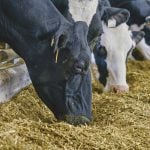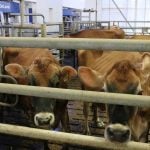Chicago | Reuters — U.S. live cattle futures settled narrowly mixed on Monday, with some contracts easing slightly after prices surged to six-month highs following strong sales in cash markets late on Friday, traders said.
Front-month October live cattle jumped to a peak of 113.975 cents/lb., highest since March 14, before settling at 113.425 cents, down 0.375 cent (all figures US$).
December live cattle edged up 0.05 cent, to 118.1 cents/lb. October feeder cattle were up 0.3 cent at 159.175 cents/lb., finishing just below Friday’s life-of-contract highs.
“The trade is building on strong exports and strong domestic demand (for beef),” U.S. Commodities analyst Don Roose said of cattle.
Read Also

U.S. livestock: Cattle futures sink on concerns over Trump’s push to lower prices
Chicago | Reuters – U.S. cattle futures tumbled on Monday, extending a steep slide after President Donald Trump complained last…
Live cattle futures on Friday had surged the three-cent daily price limit on optimism for better cash market sales. Cattle on Friday in U.S. Plains cash markets fetched $111/cwt, up from sales in the previous week of $108.
Lean hog futures also were mixed, with the October contract gaining 0.225 cent to 56.45 cents/lb. while the most-active December contract sank 1.275 cents, to 55.375 cents.
Traders continued to balance higher U.S. cash hog and wholesale pork prices with abundant supplies and the African swine fever that has resulted in culled herds in top global pork producer China.
Some U.S. hog producers may consider putting off plans to cut their hog herds amid expectations that a worsening outbreak in China could push up U.S. futures, Roose said.
“The disease has changed some of the natural liquidation that’s happening in the United States, and that’s putting pressure on the back months,” Roose said.
A new outbreak of African swine fever occurred on a farm in northern China’s Inner Mongolia, the agriculture ministry said on Monday, the second in the region, as the highly contagious disease continues to spread rapidly across the world’s top producer of pigs.
U.S. food companies kept slaughter plants shut on Monday in southeastern states swamped by Hurricane Florence as flash floods collapsed the walls of at least two hog manure pits, made roads undrivable and delayed rail shipments.
— Michael Hirtzer reports on commodity markets for Reuters from Chicago.
















